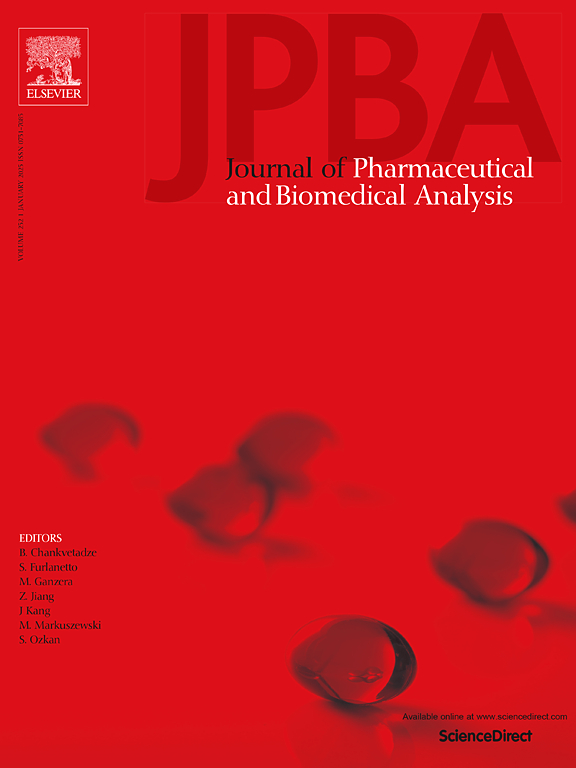Interspecies comparison on the O-methylation metabolism of LJR003, a novel immunomodulator targeting acetyl-CoA acetyltransferase 1
IF 3.1
3区 医学
Q2 CHEMISTRY, ANALYTICAL
Journal of pharmaceutical and biomedical analysis
Pub Date : 2025-04-10
DOI:10.1016/j.jpba.2025.116894
引用次数: 0
Abstract
Catechol structures are essential for drug activity and can undergo meta- or para-methylation, which affects their pharmacological properties. The regioselectivity and species differences in O-methylation metabolism significantly influence drug efficacy and toxicity, requiring further study. LJR003, an immunomodulator with a catechol structure, targets acetyl-CoA acetyltransferase 1 (ACAT1), a potential target for cancer immunotherapy. This study investigated the activity, methylation regioselectivity, and species differences of LJR003 and its methylated metabolites. Pharmacokinetic studies were conducted in rats, mice, and dogs, and methylation regioselectivity was analyzed in liver, kidney, and erythrocytes from these species and humans after LJR003 incubation. Results showed that meta-methylated LJR003 had weaker ACAT1 inhibitory activity and higher systemic exposure than LJR003 in rats, mice, and dogs. Erythrocytes exhibited the lowest methylation activity in vitro, while liver catalytic efficiency in rats, mice, and dogs was at least twice that of the kidney. In humans, liver and kidney showed similar catalytic activity. LJR003 favored meta-methylation in mice, dogs, and humans in vitro, with consistent in vivo results in mice and dogs. Rats displayed a unique metabolic pattern, suggesting species-specific differences. In conclusion, LJR003 is predicted to undergo meta-methylation in humans, contributing to its pharmacological effects alongside the parent compound. These findings improve understanding of methylation metabolism and provide insights for developing catechol-based drugs, emphasizing the importance of species-specific metabolic pathways in drug development.
针对乙酰辅酶a乙酰转移酶1的新型免疫调节剂LJR003 o -甲基化代谢的种间比较
儿茶酚结构对药物活性至关重要,可发生间甲基化或对甲基化,从而影响其药理学性质。o -甲基化代谢的区域选择性和物种差异显著影响药物的疗效和毒性,有待进一步研究。LJR003是一种具有儿茶酚结构的免疫调节剂,靶向乙酰辅酶a乙酰转移酶1 (ACAT1),是癌症免疫治疗的潜在靶点。本研究研究了LJR003及其甲基化代谢物的活性、甲基化区域选择性和物种差异。在大鼠、小鼠和狗身上进行了药代动力学研究,并在LJR003孵育后分析了这些物种和人的肝脏、肾脏和红细胞的甲基化区域选择性。结果显示,在大鼠、小鼠和狗中,meta甲基化的LJR003比LJR003具有更弱的ACAT1抑制活性和更高的全身暴露。红细胞在体外表现出最低的甲基化活性,而肝脏在大鼠、小鼠和狗中的催化效率至少是肾脏的两倍。在人类中,肝脏和肾脏显示出类似的催化活性。LJR003在小鼠、狗和人类的体外实验中倾向于元甲基化,在小鼠和狗的体内实验结果一致。大鼠表现出一种独特的代谢模式,表明物种特异性差异。综上所述,LJR003预计会在人体内发生元甲基化,这有助于其与母体化合物一起发挥药理作用。这些发现提高了对甲基化代谢的理解,并为开发基于儿茶酚的药物提供了见解,强调了物种特异性代谢途径在药物开发中的重要性。
本文章由计算机程序翻译,如有差异,请以英文原文为准。
求助全文
约1分钟内获得全文
求助全文
来源期刊
CiteScore
6.70
自引率
5.90%
发文量
588
审稿时长
37 days
期刊介绍:
This journal is an international medium directed towards the needs of academic, clinical, government and industrial analysis by publishing original research reports and critical reviews on pharmaceutical and biomedical analysis. It covers the interdisciplinary aspects of analysis in the pharmaceutical, biomedical and clinical sciences, including developments in analytical methodology, instrumentation, computation and interpretation. Submissions on novel applications focusing on drug purity and stability studies, pharmacokinetics, therapeutic monitoring, metabolic profiling; drug-related aspects of analytical biochemistry and forensic toxicology; quality assurance in the pharmaceutical industry are also welcome.
Studies from areas of well established and poorly selective methods, such as UV-VIS spectrophotometry (including derivative and multi-wavelength measurements), basic electroanalytical (potentiometric, polarographic and voltammetric) methods, fluorimetry, flow-injection analysis, etc. are accepted for publication in exceptional cases only, if a unique and substantial advantage over presently known systems is demonstrated. The same applies to the assay of simple drug formulations by any kind of methods and the determination of drugs in biological samples based merely on spiked samples. Drug purity/stability studies should contain information on the structure elucidation of the impurities/degradants.

 求助内容:
求助内容: 应助结果提醒方式:
应助结果提醒方式:


